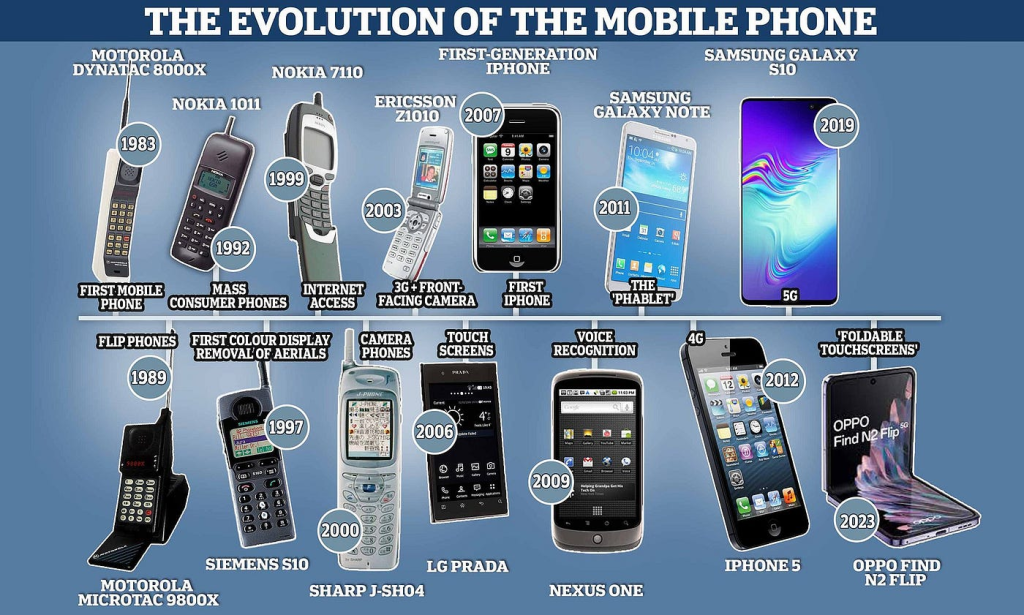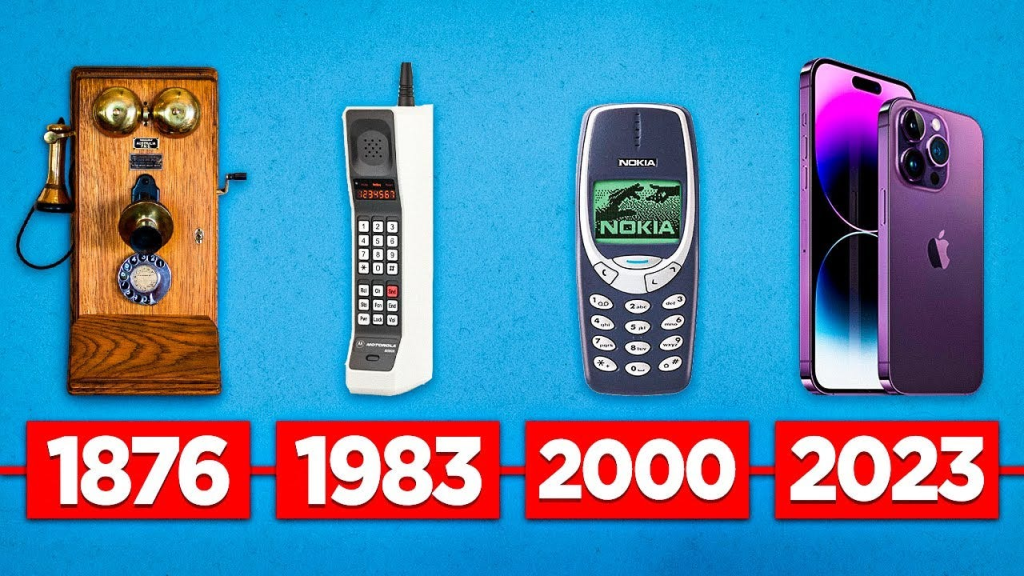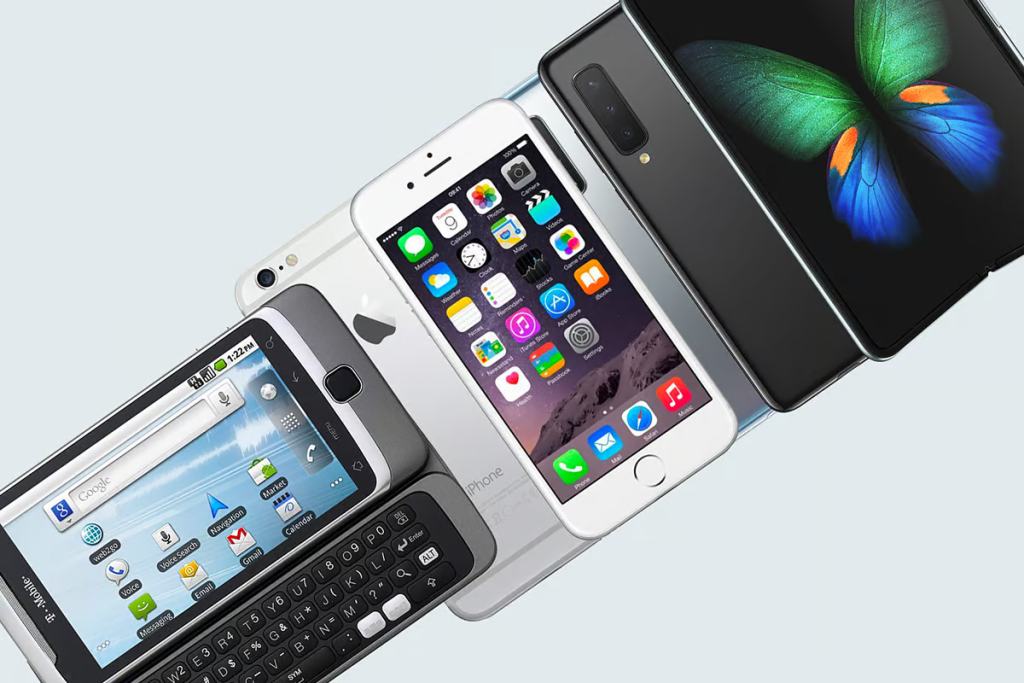The mobile phone has undergone one of the most remarkable technological evolutions in modern history, transforming from bulky, limited-function devices into the sophisticated miniature computers we carry today. This journey spans less than five decades but represents a revolution in how humans communicate, work, and interact with the world. From the earliest “brick” phones that could only make calls to today’s powerful smartphones that serve as our cameras, entertainment centers, work tools, and communication hubs, the evolution of mobile phones reflects broader changes in technology, society, and human behavior.
The Early Days: When Portable Meant “Barely Liftable”
The journey begins with devices that stretched the very definition of “mobile.”
The First Mobile Telephones
Before handheld cellular phones, mobile communication had already begun:
- Car phones (1940s-1970s): Bulky radio telephones installed in vehicles, requiring significant power and limited to a small number of available channels
- Early portable systems (1960s): Briefcase-sized devices weighing 80+ pounds, primarily used by military and emergency services
- Improved Radio Telephones (1970s): Still vehicle-based but with improved technology and gradually increasing availability
The Motorola DynaTAC: The First True Mobile Phone
In April 1973, Motorola engineer Martin Cooper made history:
- The first handheld cellular call: Cooper used a prototype to call his rival at Bell Labs, demonstrating Motorola’s breakthrough
- The commercial DynaTAC 8000X (1983): After a decade of development, the first commercially available cellular phone debuted
- Technical specifications: Weighed almost 2 pounds, measured about 10 inches tall (without the antenna), offered 30 minutes of talk time after a 10-hour charge
- Price point: Cost nearly $4,000 (equivalent to over $10,000 today)
- Cultural impact: Became a status symbol for business executives and wealthy individuals, appearing in movies and TV as a symbol of power
The “Brick Phone” Era
Through the 1980s, mobile phones maintained a distinctive bulky form:
- Gradual size reduction: Newer models were slightly smaller but maintained the characteristic brick shape
- Improved battery life: Extended talk time became a key selling feature
- Expanding networks: The growth of cellular infrastructure made mobile phones more practical in major metropolitan areas
- Limited adoption: High costs and infrastructure limitations kept mobile phones as luxury items for business use or the wealthy

The 1990s: Mobility Becomes Mainstream
The 1990s saw mobile phones transform from luxury items to everyday tools.
Smaller, Lighter, More Affordable
A dramatic transformation in form factor and accessibility occurred:
- Miniaturization breakthroughs: Advancements in battery technology, circuit board design, and materials allowed for significantly smaller devices
- The “candy bar” form factor: Rectangular phones with integrated antennas became the standard design
- Notable examples: The Motorola MicroTAC (1989), Nokia 3210 (1999), and Motorola StarTAC (1996) pioneered smaller, more pocketable designs
- Price reductions: Greater manufacturing efficiency and competition drove prices down
- Expanding user base: Mobile phones began transitioning from business tools to personal consumer devices
The Rise of Nokia and Feature Innovations
Finnish company Nokia emerged as the dominant player:
- Market dominance: By the late 1990s, Nokia controlled roughly 40% of the global mobile phone market
- Iconic designs: The Nokia 3310 (released in 2000) sold approximately 126 million units and became culturally iconic
- Durability and simplicity: Nokia devices gained a reputation for reliability and user-friendliness
- Feature innovations: Introduction of T9 predictive text, customizable ringtones, replaceable covers, and the game “Snake”
Beyond Voice: New Capabilities Emerge
Mobile phones began to expand beyond just calling:
- SMS text messaging: Originally an engineering feature, texting became wildly popular, especially among younger users
- Basic games: Simple built-in games became standard features
- Ringtone customization: Personalization through custom ringtones created a new market
- Calendar and calculator functions: Basic productivity tools appeared
- The first mobile internet attempts: Rudimentary WAP (Wireless Application Protocol) browsers provided limited internet access

The Early 2000s: Experimentation and Diversification
The new millennium brought a period of rapid innovation and experimentation in form factors and features.
Innovative Form Factors
Manufacturers explored various designs beyond the standard candy bar:
- Flip phones: Popularized by Motorola’s RAZR V3 (2004), which sold over 130 million units with its ultra-thin, metallic design
- Slider phones: Devices where the keypad slid out from behind the screen
- Swivel designs: Phones with rotating screens or keyboards
- Early touchscreens: Resistive touch technology appeared on PDAs and some phone models
- QWERTY keyboards: BlackBerry and others popularized physical keyboards for email and messaging
Camera Phones Change Photography Forever
The integration of cameras fundamentally altered both phones and photography:
- First commercial camera phones: Sharp J-SH04 (2000, Japan) and Sanyo SCP-5300 (2002, US) pioneered the category
- Image quality evolution: Rapid improvements from initial VGA (0.3MP) to several megapixels
- Cultural impact: Democratized photography, enabling instant photo sharing and documentation
- “Phonecam” journalism: Ordinary citizens could now document news events
- Privacy concerns: New questions about photography in private spaces
The Rise of the Smartphone Concept
Devices blending PDA (Personal Digital Assistant) functionality with phones emerged:
- BlackBerry dominance: Business-focused devices optimized for email and messaging
- Palm Treo series: Combined PDA organization tools with phone capabilities
- Windows Mobile devices: Microsoft’s early attempts at smartphone operating systems
- Nokia Communicator series: Early European approach to smartphone functionality
- Limitations: Complicated interfaces, stylus requirements, and high costs limited mainstream adoption
The iPhone Revolution: 2007 and Beyond
On January 9, 2007, Steve Jobs unveiled the iPhone, triggering a fundamental shift in mobile technology.
The iPhone’s Revolutionary Approach
Apple’s entry into the market changed everything:
- Multi-touch interface: Intuitive finger-based interaction instead of stylus input
- Full web browsing: First truly effective mobile web experience
- Visual voicemail: Reinvention of the basic phone function
- App ecosystem: Though the App Store came in 2008, the concept of a unified software platform was revolutionary
- Design philosophy: Emphasis on simplicity, eliminating physical keyboards and most buttons
The Android Response and Market Transformation
Google’s platform created a viable alternative:
- Open source approach: Android allowed manufacturing partners to customize the OS
- Diverse hardware options: Various screen sizes, prices, and features catered to different market segments
- Rapid adoption: Android quickly surpassed iPhone in global market share
- Feature competition: Rapid innovation as manufacturers competed with new capabilities
- Market consolidation: Smaller manufacturers and alternative operating systems gradually disappeared
Hardware Evolution in the Smartphone Era
The post-iPhone decade saw remarkable hardware advancement:
- Display technology: Evolution from early LCD to high-resolution OLED screens
- Processing power: Mobile processors approaching laptop capabilities
- Camera quality: From basic 2MP cameras to multi-lens systems rivaling dedicated cameras
- Biometric security: Fingerprint readers, facial recognition, and other secure authentication methods
- Battery technology: Improvements in capacity and charging speed
- Connectivity: From 3G to 4G/LTE to emerging 5G standards, dramatically increasing data speeds

The Mobile Phone as Life Hub: Recent Developments
Today’s smartphones have become central to daily life, expanding far beyond communication.
The App Ecosystem Transformation
Software has driven the most significant changes in how we use mobile devices:
- App proliferation: App stores now offer millions of applications
- Economy impacts: Creation of entire industries and business models
- Specialized applications: From banking to health monitoring to education
- Social media dominance: Apps like Instagram, TikTok, and Snapchat shaped by mobile-first experiences
- Mobile payments: Digital wallets and payment systems replacing physical cards and cash
From Communication to Computing Platform
Smartphones now serve as primary computing devices for many:
- Cloud integration: Seamless access to personal data across devices
- Productivity shift: Mobile-first approach to email, documents, and work tasks
- Entertainment center: Music, video streaming, and gaming on mobile devices
- AI assistants: Siri, Google Assistant, and others providing voice-controlled functionality
- IoT control: Smartphones serving as hubs for connected home devices
Recent Form Factor Innovations
After years of standard rectangular slabs, new designs have emerged:
- Bezel-less displays: Maximizing screen real estate on the device front
- Folding screens: Samsung, Huawei, and others pioneering flexible display technology
- Pop-up cameras: Mechanical solutions for full-screen designs
- Under-display technology: Cameras and fingerprint sensors integrated beneath screens
- Return of flip phones: Modern folding smartphones reimagining the classic form factor
Cultural and Social Impact
The evolution of mobile phones has fundamentally changed human behavior and society.
Communication Transformation
How we connect with others has been completely reimagined:
- Always available expectation: The presumption of constant connectivity
- Text over talk: Preference for asynchronous text communication over voice calls
- Visual communication: Rise of emoji, image sharing, and video messaging
- Global connectivity: Affordable international communication collapsing distances
- Digital relationships: Maintaining connections primarily through mobile interaction
Public Health and Wellness Considerations
The ubiquity of mobile phones has raised important health questions:
- Screen time concerns: Research on the psychological impacts of constant device use
- Sleep disruption: Effects of blue light and bedtime phone use
- Physical impacts: “Text neck” and repetitive strain considerations
- Addiction potential: Growing understanding of problematic usage patterns
- Health benefits: Fitness tracking, medical monitoring, and health information access
Digital Divide and Global Access
Mobile technology has both narrowed and created divides:
- Leapfrogging landlines: Developing nations skipping traditional telephone infrastructure
- Mobile banking revolution: Financial inclusion for previously unbanked populations
- Information access: Internet connectivity where traditional infrastructure was lacking
- New inequalities: Disparities between flagship and basic devices creating usage gaps
- Digital literacy challenges: Complexity of modern devices presenting barriers for some users
The Future of Mobile Technology
Looking ahead, several emerging trends suggest where mobile technology is heading.
Beyond the Smartphone Form
New interfaces and form factors are on the horizon:
- Wearable integration: Smartwatches, rings, and other wearables working in concert with phones
- Augmented reality glasses: Visual overlays potentially replacing direct screen interaction
- Improved foldable technology: More durable and versatile folding devices
- Modular approaches: Customizable components for specialized functionality
- Ambient computing: Distributed intelligence across multiple devices
Technical Innovations on the Horizon
Several technologies will shape future devices:
- 6G connectivity: Research already underway for the next generation beyond 5G
- Advanced AI integration: More capable on-device artificial intelligence
- Sustainable materials: Eco-friendly components and manufacturing processes
- Extended battery life: New battery chemistries and energy harvesting techniques
- Holographic and volumetric displays: Moving beyond flat screens
The Ethical Frontier
Important questions about the role of mobile technology:
- Privacy balancing: Personal convenience versus data protection
- Digital wellbeing: Designing for healthy relationships with technology
- Environmental impact: Addressing e-waste and resource consumption
- Accessibility imperatives: Ensuring technology works for people of all abilities
- Political and social power: Questions about the influence of mobile platforms
Conclusion
From the bulky “brick” phones of the 1980s to today’s sophisticated smartphones, mobile phones have undergone a remarkable transformation in a relatively short period. What began as expensive, limited-function status symbols have become affordable, essential tools that have fundamentally changed how we communicate, work, entertain ourselves, and relate to the world around us.
This evolution reflects not just technological advancement but changing human needs and behaviors. Each innovation in mobile technology—from text messaging to cameras to touchscreens to apps—has both responded to and shaped how we use these devices. The result is a symbiotic relationship between mobile technology and human culture, each influencing the development of the other.
As we look to the future, mobile technology will likely continue to evolve in ways both expected and surprising. Whether through new form factors, improved connectivity, artificial intelligence, or entirely new paradigms, the devices that began as simple portable telephones will continue their evolution, reflecting and shaping human experience in the digital age.


